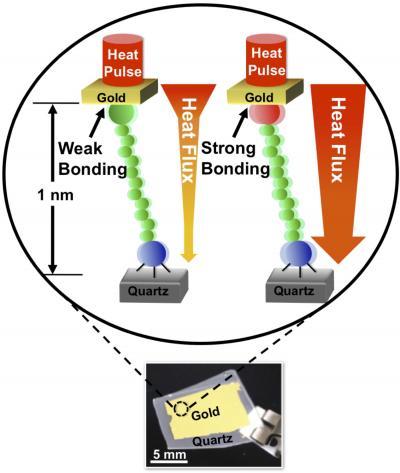Physicists have discovered a possible solution to a mystery that has long baffled researchers working to harness fusion. If confirmed by experiment, the finding could help scientists eliminate a major impediment to the development of fusion as a clean and abundant source of energy for producing electric power.
Earth
Physicists of the group of Prof. Anton Zeilinger at the Institute for Quantum Optics and Quantum Information (IQOQI), the University of Vienna, and the Vienna Center for Quantum Science and Technology (VCQ) have, for the first time, demonstrated in an experiment that the decision whether two particles were in an entangled or in a separable quantum state can be made even after these particles have been measured and may no longer exist. Their results will be published this week in the journal "Nature Physics".
Entangled States
Scientists at the University of Warwick have developed a computation which simultaneously doubles the resolution, sensitivity and mass accuracy of Fourier Transform Mass Spectrometry (FTMS) at no extra cost.
Researchers in the University's Department of Chemistry have solved the 40-year-old phasing problem which allows plotting of spectra in absorption mode.
This breakthrough can be used in all FTMS including FT-ICR, Orbitrap and FT-TOF instruments and will have applications in proteomics, petroleum analysis, metabolomics and pharmaceutical analysis among other fields.
What does lemon pan sauce chicken have to do with biochemistry and molecular biology? If you ask the students in Joseph Provost's class at Minnesota State University Moorhead, they'll tell you that successful execution of the dish requires the Maillard reaction, a chemical process that's responsible for the flavors and colors in a variety of food, including toast and maple syrup.
In Provost's class, students are asked to do what would be unthinkable in a traditional science course: eat the results of their experiments.
Researchers from New York University and the Max Planck Institute in Stuttgart reveal how protons move in phosphoric acid in a Nature Chemistry study that sheds new light on the workings of a promising fuel cell electrolyte.

Through atomic-scale manipulation, researchers at the University of Illinois have demonstrated that a single layer of atoms can disrupt or enhance heat flow across an interface.
(Photo Credit: Mark Losego)
Source:
By the time today's elementary schoolers graduate from college, the U.S. corn belt could be forced to move to the Canadian border to escape devastating heat waves brought on by rising global temperatures. If farmers don't move their corn north, the more frequent heat waves could lead to bigger swings in corn prices – "price volatility" – which cause spikes in food prices, farmers' incomes and the price livestock farmers and ethanol producers pay for corn.
Analysis of data from the IceCube Neutrino Observatory, a massive detector deployed in deep ice at the U.S. Amundsen-Scott South Pole Station in Antarctica at the geographic South Pole, recently provided new insight into one of the most enduring mysteries in physics, the production of cosmic rays.
Cosmic rays were discovered 100 years ago, but only now are scientists homing in on how the highest energy cosmic rays are produced.
Boulder, Colo., USA – Geology posted ahead of print on 19 April reports on evidence of the earliest chemical footprints of mycorrhizal fungi in a 503-million-year-old soil; a complex assemblage of trace fossils, including simple trails and branching burrow systems, in Sirius Passet, Greenland; evolution of a submarine canyon along the Ebro Margin, NW Mediterranean; and the growth of sub-tropical forests in Europe 13-17 million years ago, a crucial period for ape evolution that corresponds to their appearance there.
A scattergun approach to borehole drilling in Africa is likely to be unsuccessful.
This is the message from a group of UK researchers who have, for the first time, quantified the amount, and potential yield, of groundwater across the whole of Africa.
They estimate the total volume of groundwater to be around 0.66 million km3 – more than 100 times the available surface freshwater on the continent – and hope that the assessment can inform plans to improve access to water in Africa, where 300 million people do not have access to safe drinking water.
A study published in PLoS Computational Biology maps the development of life-sustaining chemistry to the history of early life. Researchers Rogier Braakman and Eric Smith of the Santa Fe Institute traced the six methods of carbon fixation seen in modern life back to a single ancestral form.
A University of Colorado Boulder-led team has developed a new monitoring system to analyze and compare emissions from man-made fossil fuels and trace gases in the atmosphere, a technique that likely could be used to monitor the effectiveness of measures regulating greenhouse gases.
San Francisco -- In the winter of 479 B.C., a tsunami was the savior of Potidaea, drowning hundreds of Persian invaders as they lay siege to the ancient Greek village. New geological evidence suggests that the region may still be vulnerable to tsunami events, according to Klaus Reicherter of Aachen University in Germany and his colleagues.
"Money, it's a gas," says the sixties rock group Pink Floyd in their song "Money." Indeed, physics professor Victor Yakovenko is an expert in statistical physics and studies how the flow of money and the distribution of incomes in American society resemble the flow of energy between molecules in a gas.
Boulder, Colo., USA – Five new Geosphere articles posted online today include additions to themed issues: "Exploring the Deep Sea and Beyond"; "Seeing the True Shape of Earth's Surface: Applications of Airborne and Terrestrial LiDAR in the Geosciences"; and "Geodynamics and Consequences of Lithospheric Removal in the Sierra Nevada, California." Locations studied: the Sierra Nevada, California; the San Juan volcanic field, Colorado; the western Alaska continental margin: Kodiak to Unimak; Pyramid Lake, Nevada; and the Appalachian fold-thrust belt, Pennsylvania.